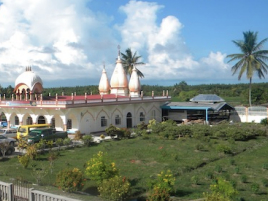“Grow More Food!”: The Guyana Mood
By Bhakti Raghava Swami | Jul 30, 2011

Guyana’s Varnasrama Committee Gives Life to New Panihati Rural Community.
Guyana is one of the smaller countries of South America with less than 1 million in population and traditionally having an agrarian based economy. In the past few decades, however, as in many other parts of the world, the social structure has been undergoing drastic changes with more and more villagers leaving their traditional occupations opting for an urban lifestyle. As a result, agriculture has been neglected. Fortunately, the present government has been pushing for agrarian reforms. One can see large boards on the highway saying GROW MORE FOOD! Some of the government policies directly support the aims and goals of an agrarian renaissance.
I was happy to learn that this was largely due to the country’s leader, President Bharrat Jagdeo, who himself is an ardent supporter of the green revolution having received the prestigious United Nation’s Environmental Program (UNEDP) 2010 Champions of the Earth award – the UN’s highest awards for environmental leadership. “President Jagdeo is a powerful advocate of the need to conserve and more intelligently manage the planet’s natural and nature-based assets. He has recognized more than most, the multiple Green Economy benefits of forests in terms of combating climate change, but also in terms of development, employment, improved water supplies, and the conservation of biodiversity.”
(http://www.caribdaily.com/article/280573/earth-day-jagdeo-receives-international-environment-award/)
This was my very first visit to Guyana not knowing what to really expect. The global initiative team called Village Initiative Committee (VIC) that was formed in February this year under the ISKCON SPT/GBC global efforts was in need of a representative from South America. Since last year I had a strong desire to visit South America to make some initial contacts. As I suspected, the climate in Guyana is most ideal for agriculture. It is reminiscent of the Indonesian Peninsula where the climate is pleasant, mild and steady all year round. In addition to green forests, one can easily find lush green pastures with an abundance of fresh tropical fruits such as coconut, papaya, mangoes, bananas, guava and many other local varieties. My timing to Guyana was ideal in that the local GBC for the country, Virabahu Das, would be visiting during this same period.
As I toured some of the ISKCON centers in the three counties of the country, New Kulinagram in Berbice, Sri Gaura Nitai Ashirvad Mandir in West Coast Demerara, Nimai Pandit Study Center in East Coast Demerara and New Navadvipa Mandir in Essequibo, including New Panihati near Berbice, I came to meet with a good number of devotees, especially those who had been serving the Yatra since the early 80ies, some even the later s70ies.
In those days, the preaching work had been quite intensive with a lot of village preaching carried along with Padayatra across the country thus attracting many thousands of villagers to become devotees. There was even a small community in the formation called New Panihati close to the town of Berbice. The devotees had installed Their Lordships Sri Sri Radha Gokula Chandraji and were growing some of their own food. After close to 20 years on this property, the devotees had to relocate.
For various reasons, the momentum has temporarily stopped but there now appears to be a rejuvenation taking place in the past few years with various Sannyasis and other senior devotees regularly visiting Guyana. As I met and spoke with devotees, I sensed a burning desire among many to revive and rejuvenate some of their temporarily unfulfilled dreams.
The day before my departure, July 25th, I was requested to participate in the National Board meeting with most of the permanent members present and was asked to share my observations and offer suggestions in relation to possible varnasrama initiatives. By Krishna’s arrangement, Virabahu Das had just arrived and was also present for the discussions. The members of the ISKCON National Board of Guyana seemed eager to restart their rural development program at the same location in New Panihati on land acquired by Ranchor Das some 15 years ago. With all present in agreement, the National Board voted to set up a National Varnasrama Development Committee to help revive and promote the varnasrama mission in Guyana. They gave a vote of thanks to Ranchor Das for having secured close to 200 acres of land for that very purpose and for his offer to have it used for developing a varnasrama based community.
The following five members make up the committee: Tridandi Das, ISKCON’s Deputy GBC for Guyana, Paramatma Das, ISKCON National Minister for Communication and Education, whom I had recently met in New Vrindavan, Ranchor Das, long-standing supporter and active preacher in Guyana, Haridas Das, a senior member of the Yatra and Ridesh, another senior preacher of the Yatra. The convener for the committee will be Paramatma Das. The varnasrama ministry in India, IDVM as well as the global initiative team for varnasrama, VIC, looks forward to seeing new developments taking place at New Panihati and other locations in Guyana.















